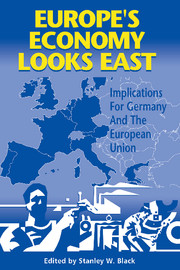Book contents
- Frontmatter
- Contents
- List of figures and tables
- Preface
- List of conference participants
- List of acronyms
- 1 Introduction
- I Trade relations
- II Investment patterns
- III Labor market issues
- IV The process of integration
- 8 Joining the club: options for integrating Central and Eastern European Countries into the European Union
- Comments
- Index
Comments
Published online by Cambridge University Press: 03 February 2010
- Frontmatter
- Contents
- List of figures and tables
- Preface
- List of conference participants
- List of acronyms
- 1 Introduction
- I Trade relations
- II Investment patterns
- III Labor market issues
- IV The process of integration
- 8 Joining the club: options for integrating Central and Eastern European Countries into the European Union
- Comments
- Index
Summary
Michael Koop has written a fine paper on the accession of the Eastern European economies to the European Union. It is an excellent summary that I have no hesitation in recommending to other readers.
If I have a quibble, it concerns the data used to show that assimilating the CEECs into the EU poses more formidable problems than did the accession of Portugal, Spain, and Greece. Koop compares the relative position of these two sets of countries today, where the more appropriate comparison is Eastern Europe today and Southern Europe fifteen years ago. Fifteen years ago the share of agriculture in GDP was 16 percent in Greece, 13 percent in Portugal, and 8 percent in Spain; according to the World Development Report, comparable figures today are 11 percent for Hungary, 7 percent for Poland, 6 percent for the Czech Republic, and 6 percent for the Slovak Republic. It is not obvious, in other words, that dependence on agriculture is more of a problem than in Southern Europe fifteen years ago.
Nor do per capita GDPs provide a clear picture of the extent of the “cohesion problem.” According to the Penn World Tables, real per capita GDP as a share of West German levels was 42 percent in Portugal, 49 percent in Greece, and 62 percent in Spain in 1980. For 1990 the Penn World Tables give ratios to Germany of 42 percent for Czechoslovakia, 37 percent for Hungary, and 27 percent for Poland.
- Type
- Chapter
- Information
- Europe's Economy Looks EastImplications for Germany and the European Union, pp. 342 - 350Publisher: Cambridge University PressPrint publication year: 1997



